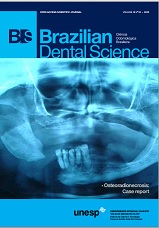Bond strength of a resin composite and a resin-modified glass-ionomer cement associated or not with chlorhexidine to eroded dentin
DOI:
https://doi.org/10.14295/bds.2015.v18i2.1101Resumo
Objective: Even resin composites and glass-ionomer cements are widely used for dental cervical region restorations, under erosive condition they can wear out quickly. This study aimed to compare, by means of bond strength by microshear, the performance of a resin composite (RC) and a resin-modified glass-ionomer cement (RMGIC) to eroded dentin and its association with 2% chlorhexidine up to 6 months. Material and Methods:. Eighty sound third molars teeth were cutt to obtain flat coronal dentin, which were subsequently embedded in self-curing acrylic resin circular molds exposing only this surface available. Teeth were divided into two groups, according to the treatment with the Adper Single Bond 2 + RC Filtek Z250 (Z) or the RMGIC Vitremer (V). Half of the specimens were immersed in artificial saliva-AS for 24 hours (control groups) and half subjected to 3x/1 minute daily immersion in Regular Coca Cola ®-RC for 5 days. Half of the specimens for each described condition were treated with water and half with 2% chlorhexidine for 1 minute prior the restoration. For all groups, the specimens were stored in artificial saliva weekly renewed up to tests. The bonding strength was evaluated by microshear test after 1 month and 6 months . Data, in normal distribution, were analyzed with 3-way ANOVA and Tukey (p <0.05). Results: Challenge factors, materials and time were statistically significant.. Restorations with Z showed significantly higher bond strength compared to V in all situations. There was a reduction in bond strength values over time for all tested conditions. The prior application of 2% chlorhexidine was able to preserve the Z bond strength between 1 and 6 months, but this factor was not statistically significant. Conclusion: For eroded dentin, the use of resin composite seems presents greater bond strength compared to resin-modified glass-material, disregarding their association to chlorhexidine or not.
Downloads
Downloads
Arquivos adicionais
Publicado
Como Citar
Edição
Seção
Licença
TRANSFERÊNCIA DE DIREITOS AUTORAIS E DECLARAÇÃO DE RESPONSABILIDADE
Toda a propriedade de direitos autorais do artigo "____________________________________________________________________" é transferido do autor(es) para a CIÊNCIA ODONTOLÓGICA BRASILEIRA, no caso do trabalho ser publicado. O artigo não foi publicado em outro lugar e não foi submetido simultaneamente para publicação em outra revista.
Vimos por meio deste, atestar que trabalho é original e não apresenta dados manipulados, fraude ou plágio. Fizemos contribuição científica significativa para o estudo e estamos cientes dos dados apresentados e de acordo com a versão final do artigo. Assumimos total responsabilidade pelos aspectos éticos do estudo.
Este texto deve ser impresso e assinado por todos os autores. A versão digitalizada deverá ser apresentada como arquivo suplementar durante o processo de submissão.




























